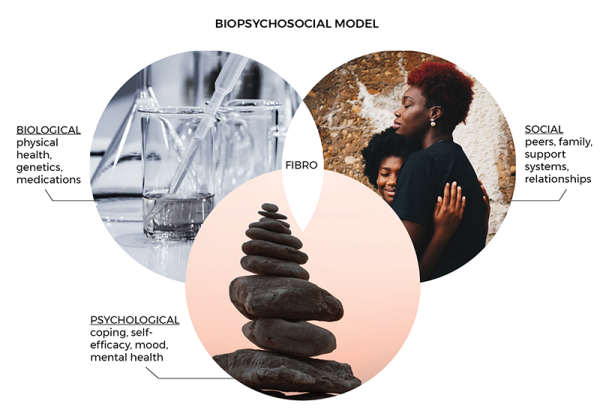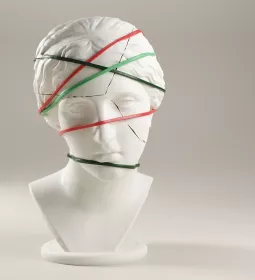Fibromyalgia syndrome, or fibro, is one of the most common, most difficult, most complex, and least understood health-related conditions ever seen. And people who live with fibro and feel abandoned, neglected, dismissed, or trivialized by the medical community often seek massage to help them cope.
Sometimes that works out well. Sometimes, not so much.
“My fibro clients wear me out.”
“I feel like a limp dishrag after a session with them.”
“After I work with a fibro person, I feel like I need a nap.”
“I never feel like I make any real progress with my fibro clients. I’m thinking I’ll just refer them out from now on.”
“I just want to fix them. Tell me how to fix them!”

I hear these kinds of comments a lot. And—here’s a bit of my embarrassing past—I sometimes said (or thought) similar things when I was new in practice and overwhelmed by the experience of working with people in chronic pain who relied on me to help them. I needed to bring not just my best massage skills, but also my best self-care skills into the session room with these clients, and I didn’t know how to do that.
While this article will look at our understanding of fibromyalgia, the main part of this piece will focus on the experience of living with fibro and what it’s like to work with clients who have fibro. I’ll share parts of my conversations with several people I interviewed for this project—who are listed at the end with my great gratitude. Our focus will be on the special attitudes and skills necessary to provide massage therapy to this population in a healthy and sustainable way.
Let’s start by looking at this syntax, used in the earlier comments: “My fibro clients.”
These words subtly reinforce the tendency to define people by their illness. In my writing and teaching, I try to use a different construction: “My clients who have fibro” is person-first language that recognizes the individual before the label of the disease. It may seem trivial, but would you rather be referred to as a fibro client, or as a client who has fibro? Which feels most respectful and empowering—the phrase that emphasizes the disease, or the one that emphasizes the person?
That baseline of respect and unconditional positive regard for our clients who have fibro and other chronic pain conditions is the central theme for this article—and these clients need us at our very best.
Fibromyalgia History and Definition
Fibromyalgia, which translates to “fiber-muscle pain,” is a situation that has been acknowledged for generations. References to body-wide pain can be found in historical documents predating the Middle Ages. But it is a surprisingly poorly understood condition that continues to be explored, so our comprehension of it is in constant evolution.
It wasn’t until 1816 that Western physicians began putting together the collection of signs and symptoms, including pain, stiffness, fatigue, and sleep disorders, into a predictable syndrome that might have been what we now call fibromyalgia. In those days, it was sometimes called muscular rheumatism, fibrositis syndrome, myofascitis, or a myriad of other names that implied inflammation. But it wasn’t until a team of researchers found no signs of inflammation in biopsied “tender points” that the more accurate term was applied. (That was using 1976 tools; since, some subtler indicators of inflammation have been detected with fibromyalgia, but not necessarily at the site of tender points.)

Historically, fibromyalgia has been conflated with a similar, but not synonymous, condition called myofascial pain syndrome (MFPS). Indeed, it is possible that what early observers documented was MFPS instead of, or in addition to, fibromyalgia. Differences between fibro-associated “tender points” and MFPS-associated “trigger points” have been noted, but this remains a touchy and controversial topic—especially since trigger points themselves have become a subject of much contention.
One widely accepted definition is this: Fibromyalgia is a neurosensory disorder characterized by abnormalities in pain processing by the central nervous system (CNS).
So, while it is named for its main symptom of widespread pain, it is a nervous system problem having to do with pain processing in the CNS. This understanding is also under challenge, as certain changes in the peripheral nervous system seem to be a problem for many people who meet the diagnostic criteria for fibro.
Regardless of whether fibro is a problem in the CNS, the peripheral nervous system, or the musculoskeletal system, its impact on people who have it is all-encompassing. For this reason it’s often discussed as a good fit for a biopsychosocial approach to coping and treatment—it has biological factors in terms of tissue and chemical changes; it has psychological factors in terms of effects on mood, self-efficacy, and the way pain is given meaning; and it has social factors because it influences relationships, socioeconomic status, the support one might need from others, and the tendency to self-isolate, which is associated with increased levels of pain. This is an important model because we see that fibro and similar conditions often don’t respond well to treatment strategies that do not address all three domains of the biopsychosocial approach.

Fibromyalgia Pathophysiology
This is the part of the discussion where I would usually dive into what physiologic changes occur with the disease under discussion so we can identify the origin of its major signs and symptoms and make some informed judgments about the appropriateness of massage therapy. However, this article is focused more on the human experience of fibro and the skills it takes to be a helpful care provider.
For a discussion of the pathophysiologic changes seen with fibro, please see the video that accompanies this article—it’s worth the 17 minutes, I promise.
For many patients, fibromyalgia begins after some type of trauma or traumas. Several people I spoke to described histories of illness, a bout of posttraumatic stress disorder, motor vehicle accidents, and other life-challenging events that precipitated their experience of chronic pain, sleep disorders, debilitating fatigue, and more.
“In 2015, I had three major health crises: the passing of a tonsil stone that was—no way to sugarcoat it—literally torture that had me clawing at my throat for a year; an accidental addiction to benzodiazepines for the throat thing, followed by withdrawal; plus the worst flu I have ever had. I have never been the same since.”
—PI
Fibro is often seen in conjunction with other pain-related chronic conditions. Most people with the disorder also meet the diagnostic criteria for one or more of the following: irritable bowel syndrome, chronic fatigue syndrome, chronic pelvic pain syndrome, migraine, and temporomandibular joint (TMJ) dysfunction. Along with the other challenges of fibro, they may also have digestive upset, debilitating headaches, pelvic pain, and more. These comorbidities, along with almost-inevitable depression and/or anxiety, complicate the process of getting a reliable diagnosis.
Living with Fibro
The list of common fibro symptoms is long and diverse. It includes widespread pain with multiple locations, which may be deep, achy, sharp, burning, tingling, or any other quality; possible tender points—although these are no longer considered definitive; insomnia and fatigue; cognitive and memory problems (sometimes described as “fibro fog”); stiffness after rest; poor stamina; and sensory amplification, where sounds, smells, textures, and other sensations become more intense and sometimes overwhelming.
“‘Fatigue’ is almost an insulting understatement—it does not communicate the profundity of what we feel. This fatigue has poisonous fangs. When I have that kind of malaise, I don’t want to be moved, I don’t want to be jostled; it’s almost like you can feel air molecules banging into you.”
—PI
“I literally feel like someone has slammed a hot poker inside my traps, and it’s on fire. All the time.”
—BC
This condition is virtually invisible, and people who have it might look healthy—but that can make it worse. From dealing with the pain, fatigue, and brain fog, to fighting for health care, to craving to be understood by colleagues and loved ones, a person with fibro has potential barriers in every direction.
“My biggest obstacle was the people around me. I think people with fibro often feel judged. Other people think you’re lazy, so you try to show you’re not. It becomes a really big thing to show that you can be a productive member of society, but then it puts me down for a week. And this is what makes people angry and frustrated.”
—KL
The presence of pain with fibro is reliable, but the quality and location of the pain is unpredictable. And some people describe feeling a weight or heavy pressure.
“Being randomly stung by invisible bees 20 times a day . . . yeah, it sucks.”
—PI
“It feels like a 10 billion-pound weight is resting on me. I can’t breathe. Everything hurts.”
—SM
“It’s an ever-present body shadow, a compression garment almost, or like wearing a wet suit that’s too tight and you can’t move.”
—BT
Others are frustrated about the unrelenting nature of the pain.
“I don’t have times when I don’t have pain. I would love that. I always have pain somewhere. It will move. It’s been in my neck for the last couple of years, but it can be in my shoulders, hips, knees, groin, wherever. So, one of the challenges is, when you get a new pain, do you go get help? Or do you just accept it?”
— BT
“Fibro fog” is another potentially incapacitating issue. Memory loss, poor concentration, and the inability to focus on complex tasks can be as challenging as pain.
“I was a type A, intelligent, go-getter-type person, and fibro kind of makes you lose all of that. There’s a mourning process for what you thought your life was going to be.”
—KL
Ultimately, people with fibro must learn how to recognize and respect their limits for exercise and other stressors. When they do, they may find those limits can be slowly and carefully expanded. But if they go too far, the consequences can be painful.
“What helped me take better care of myself and get out of that cycle is learning that limitations are not necessarily a bad thing.”
—KL
There’s much more to say about living with fibro. Each person’s experience is unique and challenging. But the throughline is this: People with this disorder do “impossible tasks” all the time—they get out of bed in the morning; they take care of others; they find ways to access inner resources of strength that most of us never have to consider. And they often do it without the help or support of a medical community that doesn’t believe fibro is a thing.
“Rest, fluids, exercise when I can—knowing my limits of how much I can do is hard sometimes. It’s hard with my grandson because he wants to play. It’s hard to learn how to say no to loved ones, to work.”
—BC
Kate Prouty, LMT, runs a clinic in Michigan where she and her staff gathered some information about their clients with fibromyalgia in an informal questionnaire. The results were fascinating (see "A Deeper Dive" below).
This survey went on to gather information for how to better serve clients with fibro. The survey asked about pleasant and unpleasant massage experiences and invited respondents to describe their ideal massage. The answers were frequently contradictory—some respondents loved hot stones, while others couldn’t stand them. Some looked forward to essential oils, while others had migraine episodes with strong scents.
The moral of the story? No two people with fibro can be treated the same way, but they all want to feel safe, reduce their stress, and be respected. And that’s all within our scope of practice.
Massage for Fibromyalgia: Adjusting Attitudes and Expectations
This section may rub some people the wrong way (pun intended), but providing massage therapy to clients who have fibro carries some particular challenges that are important to address.

Sometimes it’s wonderful! Some patients find coping strategies, including massage, that give them a sense of agency, self-efficacy, and power. They can be fun to work with, because they have come to know and appreciate their bodies and to appreciate what massage can offer them.
And sometimes working with people who have fibro is really hard. Sometimes, they are difficult clients. They don’t always have good things to say. It seems like they’re always complaining, and that massage doesn’t help them, and even like they don’t want to get better. And when we work with them, they leave us feeling tired and used up.
But even those clients—especially those clients—deserve our best care and our unconditional positive regard. It can be hard to deliver that. And in this discussion, I hope to shift some attitudes about those “difficult” clients who just “don’t want to get better.”
“It’s not them not wanting to get better, it’s that they have this nervous system that is so keyed into pain and so hyperactive, and the brain is trying to guard the body from further pain. If you want to treat the body, you have to talk to the brain.”
—GR
“Working with people who identify with fibro . . . let’s stereotype a little bit: The difficult ones tend to be heavily medicated and frustrated because they don’t get a clear picture of what they should be doing. They sound paranoid or like complainers, but that’s not really the case. They just need to be heard.”
—KL
Dysfunctional Patterns Can Be Comforting
Getting attached to dysfunctional patterns isn’t rare, and it’s not unique to people with fibro. Do you have any habits that you hold onto, even though you know they’re not good for you? I definitely do. But when I prod myself to change, my immediate internal response is, “Nope, this is my bad habit, and you can’t have it.” We cling to familiar behaviors and attitudes—even when we know they’re not good for us—because they’re familiar. We know what the outcome will be, even though we know it won’t be good. Why do we do it anyway? Well, what if the alternative is worse?
For people who live with chronic pain, including pain related to fibromyalgia, that pain can become an integral part of that person’s life and identity. That pain—invisible, private, and completely reliable—becomes, in a fully human but dysfunctional way, a defining feature of that individual’s personality. Unlike the other people in that individual’s life—their children, their partner, their work colleagues—their pain believes them. Pain is their constant companion. Pain never asks them to do more than they can do. Pain understands they can’t get out of bed today. Pain doesn’t tell them they look fine, so nothing could really be that wrong. Pain doesn’t tell them to suck it up and get on with their life. Pain is safe. So, pain becomes beloved.
Can you see how easy it is for this to happen? And people in pain tend to engage in more pain-promoting behaviors, and to avoid pain-relieving behaviors. They become isolated and sedentary; they are likely to eat poorly and sleep poorly. And the vicious cycle repeats itself: pain behaviors that reinforce pain more pain, more pain-promoting behaviors, ad infinitum.
Showing Up for a Massage is an Act of Courage
Now imagine inviting this person to step away from their pain, even for an hour. I hope you can see that it can be a big ask. If someone’s self-awareness centers on their pain, and they are invited to let go of that for just a little while, to lift away that part of their personhood, what if there’s no one left underneath?
Of course, the counterquestion is, what if the person underneath the pain is happy, loving, generous, vibrant, and eager for a chance to shine? But it’s hard for someone caught in the pain trap to see this possibility, or to make space for other experiences: the pain takes up all their attention.
“If you don’t have compassion for someone who’s living in pain, get a different job.”
—MM
Let go of pain? The prospect can be terrifying. So when clients show up for massage, that’s an act of deep courage. They deserve our appreciation and respect, even though they might present some special challenges for bodywork practitioners.
“Give grace and dig into your empathy.”
—GR
Listen
People with fibro often feel dismissed by their health-care providers. They are gaslit and told their problem is “all in their head.” Their pain is trivialized, and their experience is invalidated. One of the best things massage therapists can offer is a nonjudgmental ear to people who need to express themselves, even when it’s in a negative way.

This is not to say MTs should in any way take on the role of talk therapists. But when our client says, “I had a terrible day,” or “My life is falling apart,” or “No one gets that I am just not able to do what they want me to do,” we can acknowledge them and understand their struggles are important. We can praise them for showing up. And then we can encourage them to breathe fully, to be present in this moment, and to focus on what feels good, just for a while.
Most of all, we can believe them when they say they’re in pain, when the pressure is too much and when they need us to lighten up, or when the touch is too light and they need slower, more intense sensation.
Include Movement and Play
People with fibro, more than many other clients, are likely to be extra cautious about movement and exercise because it takes so little to throw them into a flare. But if they can detach fear from movement, they can recover or keep more function.
Massage therapists can promote this through gentle, comfortable stretching at the beginning or end (or both) of sessions. And if we can prompt clients to repeat these actions on their own, that is an empowering tool they can use to feel better. “Exercise” doesn’t have to be painful or a chore if we can help people find a way to move that feels fun and easy.
Be Present
The ability to be wholly present and invested in the moment is an important quality in every massage session, but even more so for clients who have fibro. Their needs and tolerances vary from day to day, and what was comfortable last time might be excruciating this time.
“We need to remember that the simplest things can be the most powerful. We want to share all our tricks, but sometimes, the simplest thing is just being present for somebody—that goes a really long way in these situations.”
—KL
“A lot of clients ask for pressure. What they really want is presence. What I find works best is to go slow, and to have the connection and a depth of intention, not necessarily depth of touch. If you move 1 inch over, they’ll go from ‘give me more’ to ‘that’s way too much.’ You have to tune in to what the tissue will allow from one moment to the next.”
—JN
Have Realistic Expectations
The phrase “leave your ego at the door” came up many times throughout conversations with contributors. People with fibromyalgia have a multifactoral chronic pain disorder with elements of peripheral and central sensitization, a likely history of trauma, sleep disorders, depression, anxiety, and a host of other comorbidities. Even though massage is an excellent option for disorders like fibro, 60 or 90 minutes of massage once a week or once a month is not going to solve, fix, or cure it.
We have seen that massage therapy can be a helpful part of a patient’s coping. But massage is only one part of the bigger management picture, which might also include medication, meditation, counseling, careful exercise, dietary adjustments, and much more—and even then, the disorder might not be “solved,” but it can become manageable.
The research on massage therapy for fibromyalgia is still thin, but it is consistent in a few findings: People with this disorder are eager consumers of massage; it usually takes several sessions for the benefits of massage to be felt; and moderate-pressure work tends to be more useful than lighter forms of bodywork (although this must be highly individualized).
The research doesn’t find that massage cures fibro, but it does reinforce that massage can be a much-appreciated option among many strategies.
Build Trust
Repeatedly, the people I interviewed about working with clients who have fibro emphasized how important it is to build trust. Without it, even the most brilliant bodywork won’t help. Our clients need to feel safe in our hands, and whatever we need to do to help them get there will move them toward the goal of feeling more at home in their body.
“We can help the person feel more secure and confident in their body, but we can’t do it from a cognitive perspective: You can’t think yourself out of pain. You need the body experience of safety, comfort, and movement.”
—BT
Encourage Awareness
One of the most helpful things massage therapists can do for their clients with fibro is help them connect with their bodies in a positive way and remind them about the progress they’ve made. Here are a few verbal prompts that might help clients tune in to their bodies:
- “It sounds like you had a hard day. How does that feel in your body? Let’s focus on that.”
- “What’s your favorite part of the massage? Let’s do a lot of that today.”
- (After working with one limb or side of the body and stepping back for a moment) “How does that side feel, compared with the other?”
- “Besides getting a massage, what are you doing for fun today?”
What other verbal prompts can you think of to emphasize that our bodies can be a gift?
The moral of the story? No two people with fibro can be treated the same way, but they all want to feel safe, reduce their stress, and be respected. And that’s all within our scope of practice.
Invest in Excellent Self-Care
When a massage therapist is left feeling physically and emotionally spent at the end of a session with a client who has fibro, that’s a reflection of problematic boundary-keeping. It’s more important than ever for massage therapists to not become personally invested in the outcomes of their work with people who have fibro. If we make ourselves responsible for someone else’s pain or pain relief, we can become frustrated and tired. We can feel like our work is wasted. We can lose our sense of perspective about what massage can and can’t do. And we can come to resent the clients who stir up these feelings.
Massage therapists are engaged in work that can be physically and emotionally exhausting. If we don’t take good care of ourselves, our careers will be short and frustrating. But if we do invest in good self-care, if we’re conscientious about our physical and mental health, then we can be better equipped to deal with clients who are challenging. That good self-care looks different for each person, but I encourage all massage therapists to treat themselves with the same level of compassion and attention they bestow on their clients.
That’s not to say that we shouldn’t ever “fire” our clients who have fibro. After carefully tending our boundaries and trying all our options to shift our attitudes about a client who pushes our buttons, if we still feel we can’t bring our best to this person, it is 100 percent ethically valid to refer them to another practitioner who might be better able to help them. One of the contributors to this article talked about creating a network of trusted massage practitioners in her area so they can all refer the clients with whom they don’t connect well to someone who might be a better fit.
Fixing Fibro?
Massage therapy probably won’t “fix” fibro. What our work can do is to help our clients experience their bodies in a safe, comforting, positive way. We can maybe help make the chronic pain of fibro or other pain-related conditions less important, less overwhelming. And this can make room in a person’s life for other points of focus: loved ones, fun, creativity, and so much more.
“Every single person who comes in to see me is looking for a safe place to just feel better for a little while. They’re not looking for me to fix them.”
—GR
So rather than seeing our clients who have fibro as a chore to get through, I hope we can come to see them as great opportunities for us to rise to our best. In the words of Sheree Bliss Tilsley in “A Medicine Woman’s Prayer”:
I will not rescue you.
For you are not powerless.
I will not fix you,
For you are not broken.
I will not heal you,
For I see you, in your wholeness.
I will walk with you through the darkness,
As you remember your light.
Resources
AJMC. “Dr Daniel Clauw Highlights the Turn Toward Nondrug Therapies to Treat Chronic Pain.” Accessed September 7, 2022. www.ajmc.com/view/dr-daniel-clauw-highlights-the-turn-toward-nondrug-therapies-to-treat-chronic-pain.
Bhargava, J. and J. A. Hurley. “Fibromyalgia.” StatPearls [Internet]. StatPearls Publishing. Accessed September 8, 2022. www.ncbi.nlm.nih.gov/books/NBK540974.
Boomershine, C. S. “Fibromyalgia: Practice Essentials, Background, Pathophysiology.” Medscape. Accessed August 29, 2022. https://emedicine.medscape.com/article/329838-overview.
Galosi, E., A. Truini, and G. Di Stefano. “A Systematic Review and Meta-Analysis of the Prevalence of Small Fibre Impairment in Patients with Fibromyalgia.” Diagnostics 12, no. 5 (May 2022): 1,135. https://doi.org/10.3390/diagnostics12051135.
Galvez-Sánchez, C. M. and G. A. Reyes del Paso. “Diagnostic Criteria for Fibromyalgia: Critical Review and Future Perspectives.” Journal of Clinical Medicine 9, no. 4 (2020): 1,219. https://doi.org/10.3390/jcm9041219.
Inanici, F. F. and M. B. Yunus. “History of Fibromyalgia: Past to Present.” Current Pain and Headache Reports 8, no. 5 (October 2004): 369–78. https://doi.org/10.1007/s11916-996-0010-6.
Johnson, C. “Is the Entire Autonomic Nervous System Messed Up in Fibromyalgia?” Health Rising. Accessed August 22, 2022. www.healthrising.org/blog/2022/08/06/fibromyalgia-autonomic-nervous-system.
Kalichman, L. “Massage Therapy for Fibromyalgia Symptoms.” Rheumatology International 30 (2010): 1,151–7. https://doi.org/10.1007/s00296-010-1409-2.
Kundacki, B. et al. “Efficacy of Nonpharmacological Interventions for Individual Features of Fibromyalgia.” Medscape. Accessed August 26, 2022. www.medscape.com/viewarticle/978014.
Li, Y. et al. “Massage Therapy for Fibromyalgia: A Systematic Review and Meta-Analysis of Randomized Controlled Trials.” PLoS ONE 9, no. 2 (2014): e89304. https://doi.org/10.1371/journal.pone.0089304.
Martínez-Lavín, M. “Fibromyalgia and Small Fiber Neuropathy: The Plot Thickens!” Clinical Rheumatology 37, no. 12 (2018): 3,167–71. https://doi.org/10.1007/s10067-018-4300-2.
Nadal-Nicolás, Y. et al. “Effects of Manual Therapy on Fatigue, Pain, and Psychological Aspects in Women with Fibromyalgia.” International Journal of Environmental Research and Public Health 17, no. 12, (2020): 4,611. https://doi.org/10.3390/ijerph17124611.
ScienceDaily. “Fibromyalgia Likely the Result of Autoimmune Problems.” Accessed August 22, 2022. www.sciencedaily.com/releases/2021/07/210701120703.htm.
Special thanks to the following contributors:
- Stephanie Mead, New Brunswick
- Paul Ingraham, science writer and publisher of PainScience.com, British Columbia
- Bronnie Lennox Thompson, OT, PhD, academic director of post graduate programs in pain and pain management at the University of Otago, Dunedin, New Zealand
- Mike MacAleese, LMT, owner and director of School of Holistic Massage and Reflexology, Illinois
- Jason Nadeau, LMT, New Hampshire
- Keri Lemmons, LMT, Missouri
- Gina Rogers, LMT, Michigan
- Bobbi Calvert, LMT, Pennsylvania
A Deeper Dive—Q&A with Patients with Fibromyalgia
Kate Prouty, LMT, runs a clinic in Michigan. She and her team wanted to improve their service to their clients with fibro. They created a simple survey to get a sense of their clients’ experiences, their coping mechanisms, and their preferences about massage.
This isn’t a scientific survey, and it’s not verified and reproducible data. But it does provide a snapshot into this small group of respondents, who had strong opinions about their experiences. Below are a few of their responses.
Question: How often do you experience flares (defined as a noticeable increase in symptoms)? Of 22 responses:
- 8 = 1+ flares per week
- 7 = 1–3 flares per month
So, 15 of 22 respondents had at least one flare per month. Two other respondents said they’d been in constant flare for at least nine months.
Question: What symptoms have you experienced? Of 22 responses:
- 22 had sleep issues
- 22 had painful/tender spots
- 21 had widespread pain
- 21 had fatigue
- 19 had memory issues
Other common symptoms included TMJ disorder, anxiety, and depression. Other reported symptoms included brain fog, muscle spasms, and sensitivity to pressure, light, smells, and temperature.
Question: What triggers flares? Of 22 responses:
- 19 said temperature changes
- 19 said stress
- 18 said barometric changes
Other triggers included travel, especially with time changes, not exercising regularly, and overexercising.
Question: What treatments help? Of 22 responses:
- 19 said reducing stress
- 15 said getting better sleep
- 13 said exercise
- 13 said massage therapy
- 13 said healthy eating/drinking
Other successful strategies included going to a warmer climate in winter, cannabis (gummies and topical cream), keeping to a regular schedule, heat lamps, and meditation.
Question: How does it feel to tell a health-care professional that you have fibro?
- “They do not believe me and tell me, ‘Take a Motrin.’”
- “They look at me like I’m crazy or drug-seeking. I resent being treated like an addict.”
- “I have been told that I am just lazy, I am too fat and should exercise more, and I should just pull myself up by my bootstraps.”
- “I almost cried at my first appointment with a new doctor because she was so validating.”









